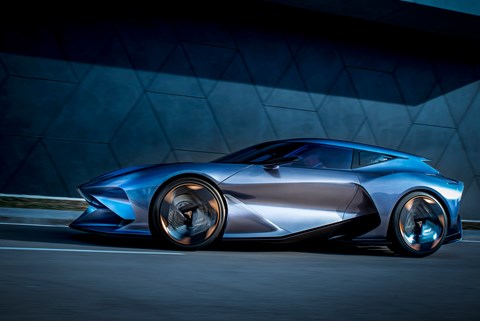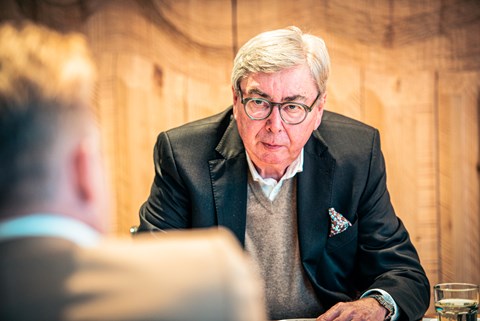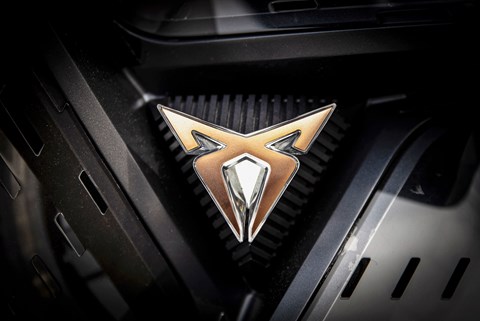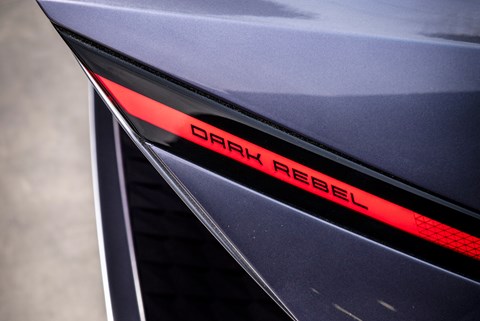► Cupra’s DarkRebel concept driven
► How the brand plans to go supernova
► With a supercar at the very top
There’s no mistaking this for some kind of rebadged Golf or ID. 3. The DarkRebel concept is an extraordinary-looking car – low, wide and mean. Crouch down to peer inside and the cabin looks futuristic enough to qualify as a work station for Darth Vader’s great grandson.
The bucket seats are fixed, but thankfully the pedal box is adjustable. The same goes for the steering wheel – part yoke, part circular joystick, featuring two large rotary controls and a pair of busy touchpads.
I clamber in. The short nose drops out of sight at the bottom of the panoramic windscreen, while the side windows are narrow enough to fire an arrow out of, but don’t give much of a view. A glance in the rear-view mirror shows a long, dark tunnel with a bright dot in the middle.

The show car is a runner, but it doesn’t go fast. The turning circle would look unwieldy on a container ship, the front spoiler would be mangled by speed bumps, and those precious hand-made copper-over-carbonfibre wheels would be painfully prone to kerb rash. While the real thing – if it ever happens – is to be equipped with an animated centre display backed up by a smaller second screen above the twisted centre stack, this one-off is devoid of any functioning instrumentation, and the remote forward/reverse/park gear selector is housed in a little black box under the driver’s seat.
What could possibly go wrong? So many things. But here goes. And it’s sensational, on several fronts: the thrill of that silent tap on the back, the raw acceleration rasp, the chafing brakes and the wow! effect this stingray has on bystanders – including Seat employees, who you might think would have got used to it.

It’s an exciting departure for Cupra, which has emerged from Seat’s shadow to become Europe’s fastest growing car maker. Most of its success has been built on products that directly or indirectly are ultimately rebadged Golfs and ID. 3s. But what’s coming is much more interesting, and much more Cupra’s own.
If it does get the nod, the most acclaimed work of chief designer Jorge Diez could become a near-supercar positioned a couple of rungs above the popular Formentor coupe-SUV, but so far Cupra CEO Wayne Griffiths has locked in neither the timing nor the funding. Perhaps more important still, he does not yet have the okay of the VW Group strategy board that ultimately decides who gets what, when, how many and at what cost.

‘I’d love an icon for sure, but right now we have other priorities which tie up the funds,’ says the Brit who’s run Cupra since 2018.
It’s conceivable that the DarkRebel could be paired with one or more of the other sporty EV projects circulating within the group, not least the TT replacement that was our March cover star, and the Porsche Boxster and Cayman successors now expected in 2025. After all, MG has managed to put the Cyberster into production, and look at the positive vibes around that.
Griffiths expects to make a decision within the next 12 months on whether to put the DarkRebel into production. Wouldn’t that be great? But then again, Cupra is doing just fine without a halo car. It currently out-performs its parent company, Seat, four to one in terms of profit margin. Rather than spending the mushrooming savings on a brand-shaping sports car, the Spaniards have more urgent matters to attend to. Like bringing fresh impetus to Seat, and launching half a dozen new models over the next four years; even preparing for a move into America, which is currently due to happen before the end of the decade and certainly won’t come cheap.
A few years back, freshly appointed VW Group CEO Herbert Diess had dismissed Seat as a lost cause – boring cars, forgettable revenues, why bother? Cupra on the other hand seemed to him worth a try. The badge had been used on hot Seats since the mid ’90s, but became a fully fledged brand six years ago, a move led by Luca de Meo, who’s now CEO of Renault.
The kick-off product, a go-faster version of the Ateca, was followed by the Leon hatch and estate in 2021. One month after Griffiths took the helm in October 2020, Cupra launched its first fully standalone model, the Formentor. Then the Born, based on the ID. 3, marked Cupra’s entry to the EV segment that will eventually become its sole battleground.
Last year was the best so far for the combined Cupra and Seat. Deliveries increased by 50 per cent, every other car sold was a Cupra, and about two-thirds of the combined profit of more than €650m was netted by the challenger brand. On its way to becoming Europe’s fastest growing car manufacturer, its conquest rate is 75 per cent.
Which all sounds great. But where are those conquest buyers coming from? An uncomfortable number of them are Audi customers.

To find out more about Cupra’s success, about Seat’s next phase and about the bigger VW Group picture, we visit Casa Seat in the heart of Barcelona. This is not an old-school headquarters but a bigger and more colourful metamorphosis of the stylish City Garages which have been set up in nine European capitals, with three more to be added in 2024; spaces where the city meets the brands in a fun, stylish and interactive kind of way.
Yes, if you want, you can stroll through showrooms and look at cars here, book a 24-hour test drive or check out the cute Seat Mó scooter. But the avant-garde steel-and-glass building on the busy Avinguda Diagonal also accommodates a part-time concert stage and exhibition space, a permanent tapas bar and restaurant, and a designer lounge area where customers and friends can meet and be merry.

On the executive floor, the majority of managers look like they’re under 30. The open-plan office is dotted at random with desks, cosy seating arrangements, areas to read or relax in and two closed doors. One leads to the chairman’s office, the other to a large, generously glazed boardroom.
The atmosphere is hip, the music loud, the lighting restless, the mood swinging between laid-back and over-revved. The message is both positively cosmopolitan and proudly Spanish. You walk through a melting pot of languages and nationalities, productive and upbeat, committed and optimistic, vibrant and restless.
This all has a lot to do with CEO Griffiths. Now 58, the son of a Midlands car dealer is fluent in German and Spanish with a Catalan twang. He leads the company on a long leash, believing in flat hierarchies, quick decisions and maximum flexibility.
But what about Seat? Isn’t that brand about to become obsolete? The answer comes like a shot: ‘Absolutely not! Cupra is earning the money Seat needs to reinvent itself. I gave the King of Spain my word that we are not going to kill Seat. And why should we? It is synonymous with cool, affordable cars – watch this space!’

Seat customers still prefer combustion engines, which will soon be complemented by advanced mild hybrids and long-range plug-in hybrids. Since the EV market share in Spain is hovering at a low 13 per cent (that’s half the EU average), Ibiza, Leon and the compact crossovers will get at least one more lease of life when their product cycles expire. The transition to battery power won’t happen for Seat before 2027 at the earliest. Cupra’s last non-BEV new model is the Terramar SUV, on sale later in 2024. Based on the MQB platform, it will be offered with a choice of plug-in and mild hybrids.
Also out in 2024 is its electric counterpart, the Chinese-built Tavascan, which uses the group’s MEBevo underpinnings. The first models to use the all-new Scalable Systems Platform SSP will be the second-edition Born and the follow-up to the best-selling Formentor, both of which are still over five years away.
What about the planned foray into micromobility as depicted by the Renault Twizy-style Seat Minimo design exercise? ‘It’s hard to make money on a minimalist vehicle like this,’ acknowledges Griffiths. ‘Perhaps Seat’s entry-level vehicle for young buyers needs to be a small no-frills electric car with a small cheap battery, because range is not of the essence here.’
He adds: ‘We embrace uncertainty, challenge the conventional, have the guts to make mistakes. We’re bold, authentic, generous – and firmly en route to become one of the 100 most valuable name plates worldwide.’
The next big thing for Cupra is the confirmed expansion into North America. At least initially, this will focus on the west and east coasts and selected metro hubs. Research has provided promising feedback. In the US, the marketing strategy is to sell not only online and through a select dealer body but also by establishing new, contemporary channels. The City Garage will get its American equivalent, and there will be an ever changing mix of pop-up and flagship stores. And, of course, interactive digital experiences everywhere all the time.
If all goes according to plan, the Spanish underdog will begin building cars in the NAFTA zone in 2029. The Audi plant in Mexico could be one option; the VW factory in Chattanooga or a US greenfield site, in a location still to be determined, may also enter the equation. Product-wise, we should see a double whammy led by the next-generation Formentor twinned with a bigger SUV that could be related to the Audi Q6 Mk2.

‘I keep thinking of Cupra as a small boat, quick and nimble, always prepared to make a move the others don’t expect,’ says Griffiths, sporting his trademark Thom Browne jacket, white shirt, matching sneakers and blue jeans ahead of a meeting with union leaders.
This will, he says, be a tough year. ‘But I’m confident we struck the right chord with the market by turning exceptional performance and stand-out design into a unique user experience. Although we are definitely on the right track, it takes a broader portfolio to co-author the next chapters of global mobility, and we also need sustainable volumes to make this thing fly. By that, I mean 100,000 cars minimum in the US and at least half a million units in total.’
It’s ambitious, and there may be casualties along the way, but recent success says the enthusiastic CEO’s instincts are good and the Cupra story has barely got into its stride – with much more potential waiting to be unleashed.